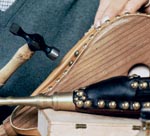Path to Perfect Paving
Using gravel correctly can really lead you somewhere, observes Ptolemy Dean


I can always remember that lovely sound of the car crunching into the gravel of my grandmother's drive in West Sussex. The sound was usually followed by a groan from my father after so many miles of winding A roads. There was then a growing crescendo of yapping, snarling and barking dogs which soon seemed to be only a very thin door away. We had arrived. The gravel had signified this, and its full value as an audible security device had been admirably demonstrated. Tarmac is somehow never the same, even if it is more practical and lasts longer. Driveways matter, and although gravel can be tiresome and messy, it is certainly to be preferred to jet-black tarmac, which can be inappropriately municipal. Nowadays, the best of both worlds can be achieved with a resin bonded version. This is normal tarmac with fine gravel bonded onto its surface so that it looks like gravel. Even if it does not sound like gravel, it is aesthetically pleasing and easy to maintain. The county council in Northamptonshire has introduced it in the paving of some its villages, and it is a pity that more local authorities have not followed suit. Where gravel is used, the key is a good subbase and the right sort of gravel. It is no good introducing the sort of riverbed pea shingle suitable for driveways in the Thames Valley into the Cotswolds, where the local crushed limestone was traditionally used, or in Scotland, where crushed granite chippings are the norm. As ever, the key is to look carefully at local traditions and to respond accordingly. Gravel may be fine to drive over, but it can be a bore to walk on. How often has one looked down to discover a stone that had lodged into one's footwear re-deposited rather embarrassingly onto someone's immaculate carpet inside? As ever, our ancestors had found an answer to this. In the Abbey Precincts of Westminster, the logic is clear. Areas where people will want to walk are paved in York stone, and the remaining margin areas are laid with gravel or, as here, pebbles. In the larger courts of the Inns of Court in London, these paved paths are of Purbeck stone blocks or brickwork, and link the entrances of the buildings in a logical and direct way. The same approach can be found in the larger gravelled quadrangles of Oxford and Cambridge colleges. The pattern of these paths both direct movement and indicate to motorists of the likelihood that pedestrians may be near. The effect only works with real stone or real brick, which has to be cut thick enough so it will not crack. Concrete or imitation stone paving never weathers well, and is no aesthetic substitute for real stone. Finally, it may sound too obvious to say, but paths and paving need to follow the desire lines where people need or want to walk. Those paths placed without any knowledge as to their use soon become green and slippery. It is an absolute lesson, which, once learned, will inform paving layout forever more. Top tips
- Gravel drives need proper sub-bases and the right gravel. Take proper
- Avoid using naked black tarmac wherever possible.
- If they are to be of any use, inset paths and paving should follow logical routes.
Sign up for the Country Life Newsletter
Exquisite houses, the beauty of Nature, and how to get the most from your life, straight to your inbox.
Country Life is unlike any other magazine: the only glossy weekly on the newsstand and the only magazine that has been guest-edited by HRH The King not once, but twice. It is a celebration of modern rural life and all its diverse joys and pleasures — that was first published in Queen Victoria's Diamond Jubilee year. Our eclectic mixture of witty and informative content — from the most up-to-date property news and commentary and a coveted glimpse inside some of the UK's best houses and gardens, to gardening, the arts and interior design, written by experts in their field — still cannot be found in print or online, anywhere else.
-
 About time: The fastest and slowest moving housing markets revealed
About time: The fastest and slowest moving housing markets revealedNew research by Zoopla has shown where it's easy to sell and where it will take quite a while to find a buyer.
By Annabel Dixon Published
-
 Betty is the first dog to scale all of Scotland’s hundreds of mountains and hills
Betty is the first dog to scale all of Scotland’s hundreds of mountains and hillsFewer than 100 people have ever completed Betty's ‘full house’ of Scottish summits — and she was fuelled by more than 800 hard boiled eggs.
By Annunciata Elwes Published
-
 How to prepare your house for winter
How to prepare your house for winterAs winter approaches, experts advise that preventative measures are crucial for our houses to weather hard winters
By Country Life Published
-
 Ten house tips for the winter
Ten house tips for the winterNow is the time to put your house in ship-shape for the winter months ahead. Chartered surveyor Tom Grillo shares his ten top tips
By Country Life Published
-
 Choosing an interior designer
Choosing an interior designerFinding the right skilled interior designer for your period property requires some dedication; in particular you need to make sure you share the same vision
By Country Life Published
-
Maintenance tips for Victorian houses
There are a number of aspects to look out for when viewing or indeed owning a Victorian house
By Country Life Published
-
 Best cooking pans
Best cooking pansMrs Danvers suggests the best makes of pots and cooking pans to hunt down when shopping for a special friend's wedding present
By Country Life Published
-
How to save old floorboards
Lots of care and elbow grease can help old floorboards gleam again
By Country Life Published
-
 Buying bellows
Buying bellowsMrs Danvers recommends where to find a new or antique pair of bellows
By Country Life Published
-
 Removing chocolate stains
Removing chocolate stainsMrs Danvers tackles readers' household queries: this week's are chocolate stains on a linen suit and screen doors
By Country Life Published
